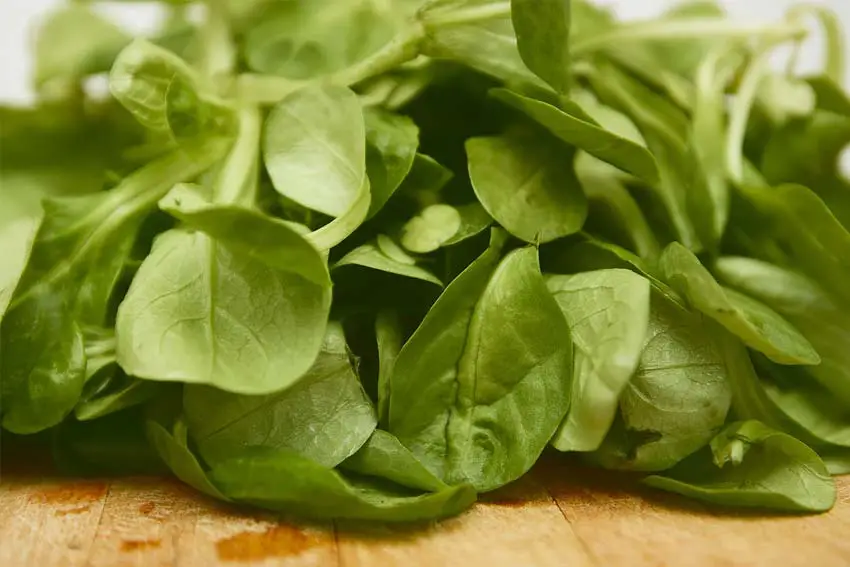Why are my spinach leaves curling?
There are more causes behind the spinach leaves curling, amongst them, attacks from pests or beetles are one of the prevalent causes of it. The cucumber mosaic virus or spinach blight is a type of bacteria transmitted by cucumber beetles that cause a sudden structural change in the leaves by curling inside.
When the spinach leaves curl (like paddle plant) inward or wrinkle, you must assume that there is a definite attack of such pests, which are aphids or cucumber beetles that are implicated in the spread of the diseases such as the cucumber mosaic virus.
Why are My Spinach Leaves Curling: Causes?

The spinach plant is naturally susceptible to several plant diseases, making it difficult to care for. The pests can easily invade the spinach field and propagate on the leaves; they suck the leaves’ juices and then the leaves crinkle inside.
Exception from bugs, another rare reason for your spinach plant’s leaves curling (like a curry leaf) inwards is bolting. Bolting causes confined plant development and is frequently caused by underwatering or excessive water stress.
When the nutrients can’t reach the leaves, they start to wrinkle because they lack the proper supply of nutrients. Again when the pests absorb the nutrients from the leaves, the leaves can’t sustain the structure.
Aside from that, avoid overexposing the spinach plant’s direct sunlight throughout the summer since this might cause the plants to bolt and finally die. Excessive sunlight may cause sunburn or leaf scorch, and being overheated thus, the leaves start to curl (like calathea).
Solution of Spinach Leaves Curling
Leaves are so much susceptible to getting attacked by many pests or insects. Though, we know that the presence of the cucumber mosaic virus is the principal cause of the curling (like Jude) of spinach plant leaves.
In that case, your initial approach should eliminate any chances of attacking the plant by any kind of pests and insects. Sometimes insects bear many viruses or aphids when they eat the leaves.
Once your plant is affected, there is nothing much you can do since the virus spreads deep into the roots, rendering them weak and unable to absorb nutrients for development. Prevention is essentially the treatment to eradicate the cucumber mosaic virus from the spinach field to stop the curling of spinach.
Find the weeds in your spinach field, not only around the plant but throughout the entire area, and carefully eliminate them. Weeds attract aphids and provide better propagation, increasing the possibility of your plants being affected by the virus.
A further simple way to protect the virus from invading your spinach plants is to buy plants that have been de-infected in the nursery and are virus-free. Plants that are virus-free abate the possibility that the presence of aphids or beetles will damage your leaves or any other part of the plant.
Netting is one of the best solutions to stop the invasion of any pests or insects, even any hazards. Further, if there is much possible to get an attack, you must use proper pesticides to get around the problem.
Some Associated Spinach Pests Causes for Curling
In addition to the cucumber mosaic virus, several insects or pests that feed on the spinach plant’s leaves are the most prevalent causes. They are directly or indirectly responsible for the spinach leaves curling (like the aloe).
Along with the insect’s indication, given the solution, you need to be aware of being attacked by it. However, the following are the most pervasive spinach pests that attack these plants:
Cutworms and Wireworms
Tender seedlings are more intriguing to these insects than older transplants to attack. Remove the wireworms from the spinach field every two or three days, they make the plant susceptible to attack by the virus.
In these cases, the soil-dwelling bacteria Bacillus Thuringiensis as Bt spray or spinosad spray is applied as an organic insecticide spray effective against cutworms.
Flea Bugs
Flea bugs eat the young leaves of spinach plants. The destruction consists of several microscopic holes that make the leaf appear to have been struck by a shattering blast.
The bugs are so small that you’ll never notice them. The holes are convenient for the virus to attack.
It will help if you lay sheets of aluminum foil or reflective mulch beneath the plants. Insecticides such as carbaryl and pyrethrum can occasionally help lessen severe infestations.

Slugs and Snails
Slugs and snails eat spinach leaves and make holes in them. The size of the hole slug and snail holes are substantially more extensive, and the slime trail slugs and snails leave behind some indicators.
Sometimes these types of insects consist of viruses from any affected plant and spread all over the attack. Baits and traps are the most effective means of removing these pests.
Aphids
Aphids are spinach’s most prevalent pest, also called the biological enemy. The most pervasive cause behind spinach leaves cupping/curling is aphids.
It would help if you had the assistance of insecticidal soaps or neem oil, which can eliminate the aphids.
Leaf Miners
Miners of leaves form meandering tan tracks, for which contact insecticides are ineffective because they eat within the leaves and, most prevalently, bring the virus to the plant.
In such cases, you should remove contaminated leaves and destroy them before their larvae can grow.
Safety Precaution for Spinach Leaves Curling
Your hands may be a highly potent transmission from an infected plant to a healthy plant, and we may be unaware of it most of the time. If at all possible, change your gardening gloves every second or third usage.
Before reusing, either discard or adequately wash them. This minor modification can result in significant improvements in the form of your spinach plant’s leaves curling (e.g. olive tree leaves).
When you detect apparent evidence of the virus on your plant, isolate it from the rest of your plants and get rid of it as soon as possible. The virus can spread quickly from infected to healthy plants, even with the wind.
Finally, you can spray your spinach field with a systemic pesticide containing the chemical imidacloprid early in the morning. It is a commercial chemical that is non-toxic to people, helpful to pollinators, and lethal to harmful insects such as aphids.
A video on spinach leaves harvesting details and solutions to the issues:
A fun fact about spinach according to Specialtyproduce.com:
Spinach is a native vegetable of Iran. It got in Nepal and China around 647 CE. The first introduction of spinach in Europe was in 827 CE in Italy by the Arabs. And, by the 10th century, spinach was well-known around the Mediterranean areas.
Red Spinach Information, Recipes and Facts (specialtyproduce.com)
Summary of Spinach Leaves Curling Problem
There are many reasons behind the spinach leaves curling issue (as for yucca). In contrast, Cucumber mosaic virus is one of the most common varieties, transmitted by cucumber beetles and aphids, also known as spinach blight.
It can induce twisted and curled inward leaves in certain spinach varieties, even it can also cause yellowing of leaves and plant death. By enhancing awareness against upper insects and pests and maintaining the guidelines and proper steps, you can diminish the spinach leaves curling. Also, you may create healthy circumstances in your garden.
I think you have got your answer to the question “why are my spinach leaves curling?”. Happy gardening!

I’m Shofi, a passionate gardener and blogger. I have 10+ years of experience in gardening and hold certifications in horticulture and garden design. I share my knowledge and skills through my garden blog to inspire and educate others on the joys of gardening. I try to provide valuable information and create a community for gardeners of all levels to connect and learn. My ultimate goal is to inspire others to start their own gardens and connect with nature.
